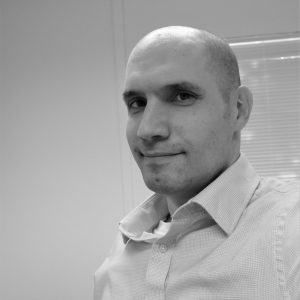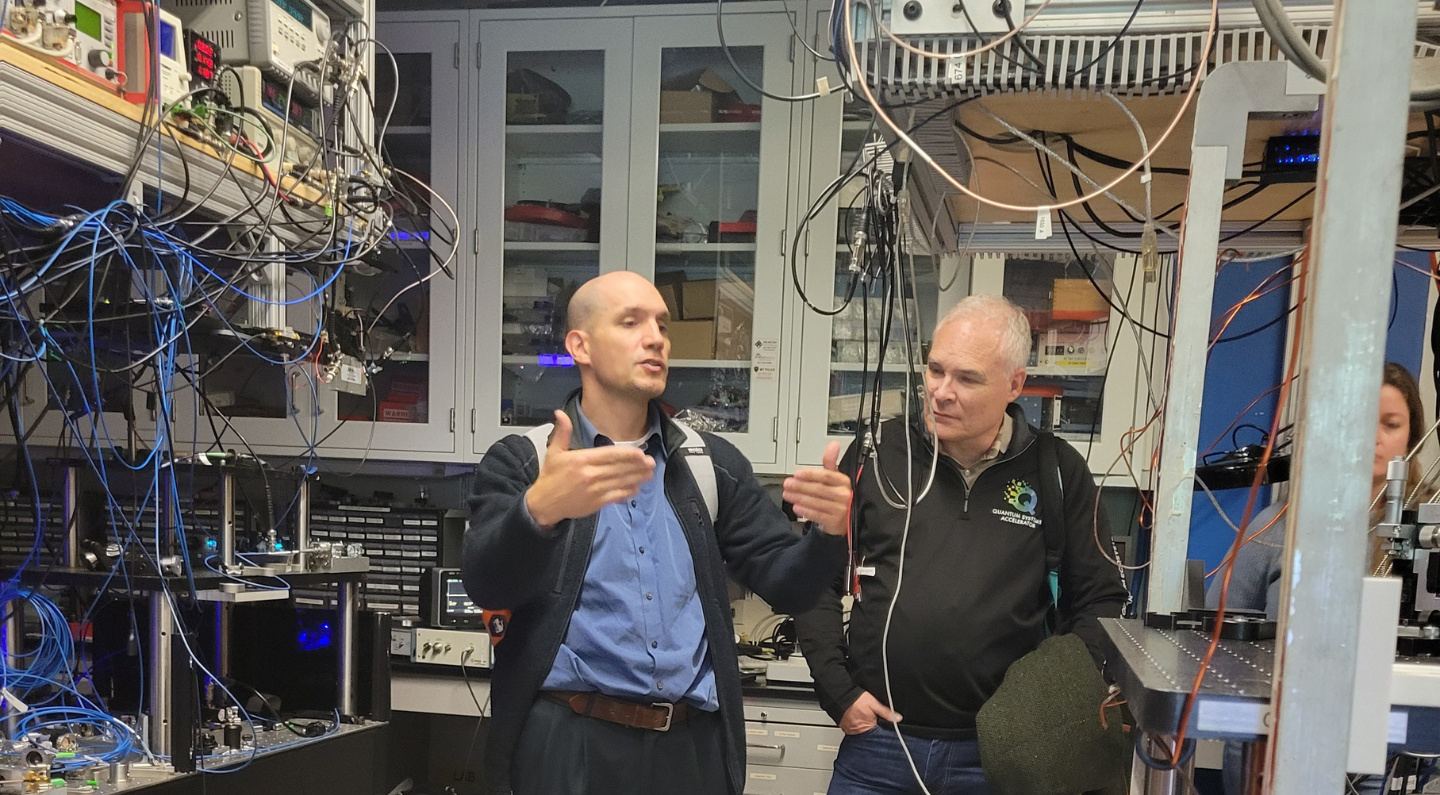As the International Year of Quantum Science and Technology unfolds, the Quantum Systems Accelerator (QSA) embodies collaboration that drives innovation and discovery in this rapidly evolving field. Established in 2020, QSA is a U.S. Department of Energy (DOE) National Quantum Information Science (QIS) Research Center. QSA brings together a collaborative team of researchers across North America to advance the frontiers of QIS and technology.
QSA’s collaborative spirit is exemplified by John Chiaverini, a scientist at MIT Lincoln Laboratory whose research focuses on trapped-ion quantum information processing. Chiaverini investigates how integrated technologies, novel techniques, and advanced encodings can overcome challenges to practical quantum computing and sensing. He holds a BS in physics from Case Western Reserve University and a PhD from Stanford University. After postdoctoral work at the National Institute for Standards and Technology (NIST) in Boulder, Colorado—where he implemented quantum algorithms using trapped ions and developed pioneering surface-ion-trap technology—he joined Los Alamos National Laboratory’s Physics Division. Fifteen years ago, he moved to MIT Lincoln Laboratory, where he co-founded and now leads the trapped-ion team. At MIT, he also supports campus groups, serves as a Principal Investigator, and advises students and postdoctoral researchers.

Interdisciplinary Collaboration and Center Dynamics
Q: As QSA’s successes build up, what are your team’s most ambitious scientific or technological objectives, and how do you plan to leverage the QSA’s collaborative ecosystem to achieve them?
Chiaverini: My team works to enable more robust and extensible quantum information processing with trapped atomic ions manipulated with radio frequency and optical fields. One of the most significant long-term challenges in building a quantum computer capable of solving broadly relevant problems—such as simulating chemical or high-energy systems—is preserving the high performance seen in small-scale systems as the number of quantum information carriers (qubits) increases.
A possible solution to this challenge is modularity, which enables the creation of standardized, reproducible units containing groups of qubits that can be scaled as required. To achieve the benefits of modularity in a quantum system, one must establish and maintain a fast, coherent connection among the modules. To this end, QSA researchers are pursuing single-photon-based interconnects to provide inter-module communication.
Ions typically have transitions in the optical wavelength range. Spontaneously emitted photons from a pair of ions—one in each of two modules—can produce entangled states between the ions. This entanglement is a valuable resource for high-connectivity quantum information processing across the modules.
The technique of photon-mediated entanglement holds great promise, but moving beyond the proof-of-principle stage will likely require a more integrated approach than the bulk-optics approaches for photon collection and manipulation used today. Our team envisions using photonic waveguide technology to collect photons directly into waveguides integrated within the same chip that traps each ion. These photons can then be routed through on-chip optical circuits to generate entanglement.
Using on-chip components could enable the dense collection of light from multiple ions into phase-stable beam paths, potentially allowing for multiplexing strategies that boost entanglement rates while reducing the imperfections typically seen with free-space optical systems. That’s the working hypothesis. However, designing and fabricating integrated optics capable of operating with the precision needed at the single-atom and single-photon level remains a major technical challenge.
Our team at MIT Lincoln Laboratory will lean heavily on the expertise within QSA to help us take bigger steps. In particular, our collaboration with Duke University—whose researchers are leaders in exploring the limitations and possibilities of photon-mediated entanglement—will be instrumental as we refine entanglement-generation protocols for integrated photonic systems. We will also leverage the substantial infrastructure built up at Sandia Labs for ion trap microfabrication and high-fidelity quantum operations to develop novel photonics designs to increase the efficiency and fidelity of photon collection. Being part of QSA provides a unique opportunity to work alongside leading experts worldwide in advanced technologies and fundamental science. This environment fosters fresh insights into common challenges, fueling innovative breakthroughs in research.
Reflections about QSA’s Mission and the Growing Field
Q: Where do you see the balance between foundational science and application-oriented development in QSA’s mission?
Chiaverini: A clear, tangible goal helps focus our efforts by providing an important benchmark for measuring progress. However, this goal should not be seen as the ultimate endpoint of our quantum research. If we limit ourselves to just this target, we risk missing out on unexpected discoveries along the way—discoveries that often lead to the most significant long-term breakthroughs.
This is especially true since we do not know how to build a functional quantum computer yet. Likewise, focusing all efforts on realizing a particular technology for quantum computing would limit future applicability and the extension of these technologies to other areas of human endeavor. We must, therefore, remain flexible and look where the research takes us, turning over rocks to uncover both the weird and the new.
I apply this lesson from my experience to every project I undertake. Much of my work over the past two decades has focused on developing a quantum computer. However, what we believed was necessary 20 years ago is not exactly what we are pursuing today. The most complex challenges evolve based on the experiments we can perform in the lab. For example, we once thought that adding more ions into a segmented ion trap would bring us closer to our goal. However, more profound insights into how atoms emit light—and how that light can be confined and transmitted through materials—have revealed a promising new approach to scaling up quantum computers. We now aim to test this method experimentally, potentially opening a new path for the practical control of quantum states.
Regarding application-driven research and fundamental science, QSA has the expertise to get the job done! Our team includes broad and specialized experts in QIS, atomic physics, and condensed-matter physics, enabling us to tackle key questions about the behavior and control of matter at the quantum level. While keeping practical applications in mind helps guide our efforts, we also focus on identifying and formalizing overarching principles that connect these fields to ensure our work remains valuable over the long term. Our goal is to create the best qubits possible and build a foundation that future researchers can build on, achieving breakthroughs we can’t yet imagine. I would love to see that!
Lawrence Berkeley National Laboratory (Berkeley Lab) is committed to groundbreaking research focused on discovery science and solutions for abundant and reliable energy supplies. The lab’s expertise spans materials, chemistry, physics, biology, earth and environmental science, mathematics, and computing. Researchers from around the world rely on the lab’s world-class scientific facilities for their own pioneering research. Founded in 1931 on the belief that the biggest problems are best addressed by teams, Berkeley Lab and its scientists have been recognized with 16 Nobel Prizes. Berkeley Lab is a multiprogram national laboratory managed by the University of California for the U.S. Department of Energy’s Office of Science.
DOE’s Office of Science is the single largest supporter of basic research in the physical sciences in the United States, and is working to address some of the most pressing challenges of our time. For more information, please visit energy.gov/science.
Sandia National Laboratories is a multimission laboratory operated by National Technology and Engineering Solutions of Sandia LLC, a wholly owned subsidiary of Honeywell International Inc., for the U.S. Department of Energy’s National Nuclear Security Administration. Sandia Labs has major research and development responsibilities in nuclear deterrence, global security, defense, energy technologies and economic competitiveness, with main facilities in Albuquerque, New Mexico, and Livermore, California.
The Quantum Systems Accelerator (QSA) is one of the five National Quantum Information Science Research Centers funded by the U.S. Department of Energy Office of Science. Led by Lawrence Berkeley National Laboratory (Berkeley Lab) and with Sandia National Laboratories as lead partner, QSA catalyzes national leadership in quantum information science to co-design the algorithms, quantum devices, and engineering solutions needed to deliver certified quantum advantage in scientific applications. QSA brings together dozens of scientists who are pioneers of many of today’s unique quantum engineering and fabrication capabilities. In addition to industry and academic partners across the world, 15 institutions are part of QSA: Lawrence Berkeley National Laboratory, Sandia National Laboratories, University of Colorado at Boulder, MIT Lincoln Laboratory, Caltech, Duke University, Harvard University, Massachusetts Institute of Technology, Tufts University, UC Berkeley, University of Maryland, University of New Mexico, University of Southern California, UT Austin, and Canada’s Université de Sherbrooke. For more information, please visit https://quantumsystemsaccelerator.org/
